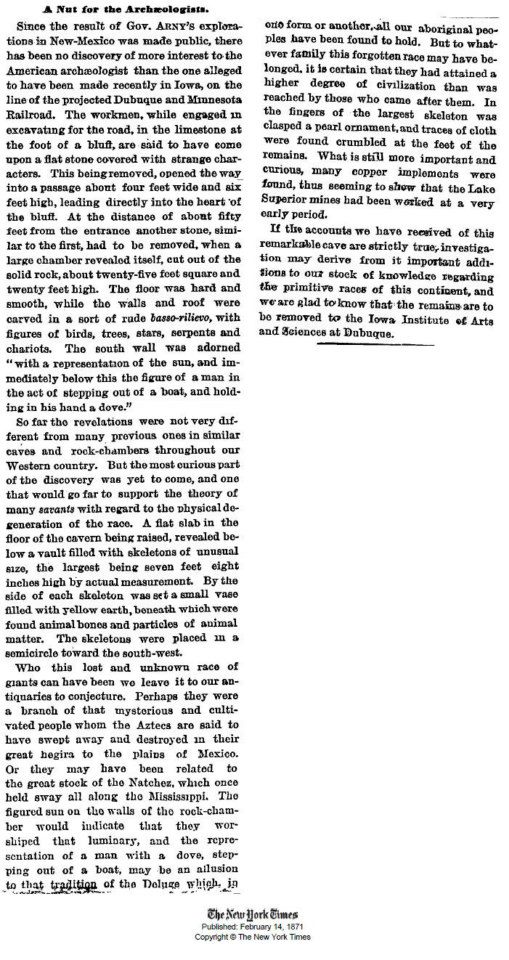7 feet 8 with copper implements
7 feet 8 with copper implements
 A Nut for the Archaeologists
A Nut for the Archaeologists
Since the result of Gov. Arny’s exploration in New Mexico was made public, there has been no discovery of more interest to the American archaeologist than the one alleged to have been made recently in Iowa, on the the line of the projected Dubuque and Minnesota Railroad. The workmen while engaged in excavating for the road, in the limestone at the foot of the bluff, are said to have come upon a flat stone, covered with strange characters. This being removed, opened the way into a passage. about four feet wide and six feet high, leading directly into the heart of the bluff. At the distance of about fifty feet from the entrance another stone, similar to the first, had to be removed, when a large chamber revealed itself, cut out of solid rock, about twenty-five feet square and twenty feet high. The floor was hard and smooth, while the malls and roof were carved in a sort of rude basso-relievo, with figures of birds trees, stars, serpents and chariots. The south was was adorned “with a representation of the sun, and immediately below this the figure of a man in the act of stepping out of a boat, and holding in his hand a dove. ”
So far the revelations were not very different from many previous ones in similar caves and rock-chambers throughout our Western country. But the most curious part of the discovery was yet to come, and one that would go far to support the theory of many savants with regard to the physical degeneration of the race. A flat slab in the floor of the cavern being raised, revealed below a vault filled with skeletons of unusual size, the largest being seven feet eight inches high by actual measurement. By the side of each skeleton was a set of small vase filled with yellow earth, beneath which were found animal bones and particles of animal matter. The skeletons were placed in a semicircle toward the south-west.
Who this lost and unknown race of giants can have been we leave it to our antiquities to conjecture. Perhaps they were a branch off that mysterious and cultivated people whom the Aztecs are said to have swept away and destroyed in their great hegira to the plains of Mexico. Or they may have been related to the great stock of the Natchez, which once held sway all along the Mississippi. The figured-sun on the walls of the rock-chamber would indicate that they worshipped that luminary, and the representation of a man with a dove, stepping out of a boat, may be an allusion to that tradition of the Deluge which in one form or another, all our aboriginal peoples have been found to hold. But to whatever family this forgotten race may have belonged, it is certain that they have attained a higher degree of civilization than was reached by those who came after them. In the fingers of the largest skeleton was clasped a pearl ornament, and traces of cloth were found crumbled at the feet of the remains. What is still more important and curious, many copper implements were found, this seeming to show that the Lake Superior Mines had been worked at a very early period.
If the accounts we have received of this remarkable cave are strictly true, investigation may derive from it important additions to our stock of knowledge regarding the primitive races of this continent, and we are glad to know that the remains are to be removed to the Iowa Institute of Arts and Sciences in Dubugue.
- THE NEW YORK TIMES, Published February 14, 1971
Comment